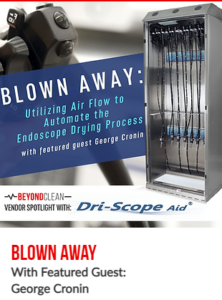Resources
Continuing Education – Endoscope Drying (1 CE Credit)
The goal of this program is to understand…
- WHY we need to dry our scopes
- HOW we can accomplish this
- WHAT is out there to automate the process.
The program is a 1 hour presentation either in person or through a webinar.
Research and Articles
The Dri-Scope Aid® team has done some research for you. The research below not only focuses on WHY you should be drying, but HOW you can accomplish this important step in your reprocessing cycle.
15-Minute Forced-Air Drying Removes Simethicone Droplets in Endoscope Working Channels
Results: After 10 minutes of automated drying, some rare fluid retention persisted (see table). After 15 minutes of automated drying, no visible fluid droplets remained for any of the three concentrations of Simethicone.
Monique Barakat, MD Stanford GI/Peds GI EXTENDED AUTOMATED DRYING PREVENTS SIMETHICONE-ASSOCIATED MOISTURE RETENTION IN COLONOSCOPES
Fluid retention in endoscopes: A real-world study on drying effectiveness
Results: Researchers evaluated drying during encounters with 22 gastroscopes and 20 colonoscopes. After default AER alcohol and air purge cycles, 100% (42/42) of endoscopes were still wet. Substantial fluid emerged from distal ends during the first 15 seconds of the FADS cycle, and droplets also emerged from air/water and suction connectors. Following FADS cycle completion, 100% (42/42) were dry, with no retained fluid detected by any of the assessment methods.
Cori L. Ofstead, MSPH Krystina M. Hopkins, MPH Aaron L. Preston, RN, BSN, CIC Abigail G. Smart, MPH Larry A. Lamb, AGTS Kari L. Love, RN, MS, CIC, FAPIC
Open Access Published: February 24, 2024
Alcohol flush does not aid in endoscope channel drying but may serve as an adjunctive microbiocidal measure: A new take on an old assumption
Results: Alcohol flush (70%-30%) prevented outgrowth with little to no recovery of P. aeruginosa during ambient storage. 70% alcohol increased channel drying time by 1.5 or 3-fold compared to 50% alcohol or water, respectively. Forced air drying of non-alcohol flushed channels greatly reduced the initial contamination level and prevented outgrowth. Incomplete drying of contaminated channels was akin to no application of forced air. Applying forced air for more time than necessary to remove residual liquid did not completely eliminate the low level recovery of P. aeruginosa.
Michelle Nerandzic, BS Kathleen Antloga, MS Nancy Robinson, PhD
Open Access Published: September 18, 2022
Comparison of automated and manual drying in the elimination of residual endoscope working channel fluid after reprocessing (with video).
Results: Significantly more fluid droplets were evident after manual drying than with automated device-facilitated drying for either 5 minutes (.83t 1.29: P=.007) or 10 minutes (0 t 0: P=.001). ATP bioluminescence values were higher for manual drying compared with automated drying at 48 and 72 hours after reprocessing.
Barakat MT1, Huang RJ1, Banerjee S1 Division of Gastroenterology and Hepatology, Stanford University School of Medicine, Stanford, CA
Gastrointest Endosc. 2019 Jan;89(1):124-132.e2. doi: 10.1016/j.gie.2018.08.033. Epub 2018 Aug 25
Endoscope reprocessing: Comparison of drying effectiveness and microbial levels with an automated drying and storage cabinet with forced filtered air and a standard storage cabinet.
Results: Using the automated drying and storage cabinet, internal channels were dry at 1 hour and external surfaces at 3 hours in all endoscopes. With the standard storage cabinet, there was residual internal fluid at 24 hours, whereas external surfaces were dry at 24 hours. For bronchoscopes, colonoscopes, and duodenoscopes, the standard cabinet allowed for an average rate of colony forming unit growth of 8.1 × 106 per hour, 8.3 × 106 per hour, and 7.0 × 107 per hour, respectively; the automated cabinet resulted in colony forming unit growth at an average rate of -28.4 per hour (P = .02), -38.5 per hour (P = .01), and -200.2 per hour (P = .02), respectively.
Perumpail RB1, Marya NB1, McGinty BL2, Muthusamy VR3 David Geffen School of Medicine at UCLA, Los Angeles, CA Department of Gastroenterology Services, Northside Hospital, Atlanta GA
Am J Infect Control. 2019 Apr 6. pii: S0196-6553(19)30104-X. doi: 10.1016/j.ajic.2019.02.016
Residual moisture and waterborne pathogens inside flexible endoscopes: Evidence from a multisite study of endoscope drying effectiveness.
Results: Fluid was detected in 22 of 45 (49%) endoscopes. Prevalence of moisture varied significantly by site (5%; 83%; 85%; P < .001). High adenosine triphosphate levels were found in 22% of endoscopes, and microbial growth was detected in 71% of endoscopes. Retained fluid was associated with significantly higher adenosine triphosphate levels (P < .01). Reprocessing and drying practices conformed with guidelines at 1 site and were substandard at 2 sites. Damaged endoscopes were in use at all sites.
Ofstead CL1, Heymann OL2, Quick MR2, Eiland JE2, Wetzler HP2 Ofstead & Associates, Inc Saint Paul, MNAm J Infect Control. 2018 Jun;46(6):689-696. doi: 10.1016/j.ajic.2018.03.002. Epub 2018 Mar 30.
Videos
Dri-Scope Aid® Jet-Stream Quick Start Guide
Dri-Scope Aid® Jet-Stream Out of the Box Setup
Dri-Scope Aid® Jet-Stream
Filter Replacement & Pressure Test
Dri-Scope Aid® Cabinet
